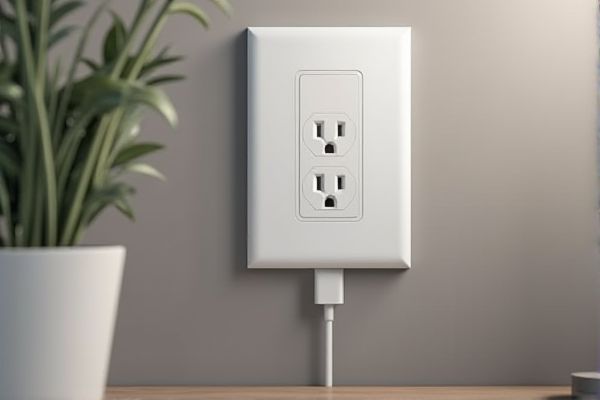
Fast charging outlets deliver significantly higher power output, reducing your device's charging time compared to standard outlets that provide a consistent but slower current. Understanding the differences can help you choose the best charging solution for your needs; continue reading to explore more about these outlets' benefits and compatibility.
Table of Comparison
| Feature | Fast Charging Outlet | Standard Outlet |
|---|---|---|
| Charging Speed | Up to 4x faster | Standard speed |
| Power Output | 30W to 100W+ | 5W to 15W |
| Supported Devices | Compatible with fast-charging smartphones, tablets, laptops | Compatible with all USB-charging devices |
| Technology | Supports USB Power Delivery (PD), Qualcomm Quick Charge | Basic USB charging standards |
| Heat Management | Advanced protection to prevent overheating | Standard thermal safety |
| Cost | Higher upfront cost | Lower cost |
| Use Case | Ideal for quick battery top-ups and heavy device users | Suitable for regular, low-speed charging |
Understanding Fast Charging Outlets
Fast charging outlets deliver higher wattage compared to standard outlets, allowing your devices to charge significantly faster by providing increased current and voltage levels. These outlets often support advanced technologies such as USB Power Delivery (USB-PD) or Qualcomm Quick Charge, optimizing power output based on your device's requirements. Choosing a fast charging outlet can improve your charging efficiency and reduce the time your devices spend plugged in.
What Is a Standard Outlet?
A standard outlet, also known as a traditional or regular electrical outlet, typically provides 120 volts of alternating current (AC) power with a current rating of 15 to 20 amps, suitable for everyday household devices. It usually features two vertical slots and a grounding hole designed to accommodate common plugs for lamps, chargers, and small appliances. Unlike fast charging outlets, standard outlets deliver power at a fixed rate without integrated technology to optimize or speed up charging times for electronic devices.
Key Differences: Fast Charging vs Standard Outlets
Fast charging outlets deliver a significantly higher power output, typically ranging from 15 to 50 watts or more, compared to standard outlets that provide around 5 to 7 watts, enabling your devices to recharge much faster. These outlets use advanced technology like USB Power Delivery (USB-PD) or Qualcomm Quick Charge to optimize voltage and current for speedy, efficient power transfer. Choosing a fast charging outlet over a standard one ensures reduced downtime and improved convenience for your smartphone, tablet, or laptop charging needs.
Charging Speed Comparison
Fast charging outlets deliver power at rates significantly higher than standard outlets, typically offering 15 to 30 amps compared to the standard 5 to 10 amps. This allows devices like smartphones and laptops to reach 50% charge in under 30 minutes, whereas standard outlets may require 2 to 4 hours for the same level of charge. The increased amperage and voltage provided by fast charging outlets optimize energy transfer efficiency, drastically reducing overall charging time.
Device Compatibility and Requirements
Fast charging outlets support devices equipped with USB Power Delivery (PD) or Qualcomm Quick Charge technology, enabling significantly reduced charging times compared to standard outlets. Standard outlets provide consistent power output suitable for basic devices but lack the advanced protocols required for optimized fast charging. Ensuring device compatibility with fast charging outlets requires checking both the charger's specifications and the device's support for required charging standards to prevent damage or inefficient charging.
Safety Considerations and Precautions
Fast charging outlets incorporate advanced safety features such as overcurrent protection, temperature monitoring, and short-circuit prevention to reduce risks associated with high power flow. Standard outlets lack these specialized protections, increasing the potential for electrical hazards when used with fast-charging devices. Ensuring proper installation by certified electricians and using compatible, certified chargers further enhances safety in fast charging applications.
Installation Costs and Processes
Fast charging outlets typically require higher installation costs due to the need for upgraded electrical panels, dedicated circuits, and compliance with stricter safety standards. Standard outlets involve simpler installation processes with lower expenses, as they use existing wiring systems and do not require specialized equipment. The complexity and cost associated with fast charging installations can vary based on the building's electrical infrastructure and local regulations.
Energy Efficiency and Consumption
Fast charging outlets deliver higher power output, reducing your device's charging time while often enhancing energy efficiency by minimizing energy lost during prolonged charging sessions. Standard outlets supply lower power, resulting in longer charging periods that may increase overall energy consumption due to extended electricity draw. Choosing fast charging technology can optimize energy use by quickly replenishing battery capacity, thereby lowering total energy expenditure compared to standard outlets.
Pros and Cons of Fast Charging Outlets
Fast charging outlets significantly reduce device charging time by delivering higher power output compared to standard outlets, making them ideal for quickly powering smartphones, laptops, and electric vehicles. However, the increased power can generate more heat, potentially shortening battery lifespan and requiring compatible devices to maximize efficiency. Standard outlets offer universal compatibility and lower heat generation but charge devices at a slower rate, which may be inconvenient for time-sensitive charging needs.
Choosing the Right Option for Your Needs
Fast charging outlets deliver higher power output, significantly reducing device charging times compared to standard outlets, which provide a lower, steady current suitable for everyday use. Assessing your device compatibility, charging speed requirements, and power consumption helps determine the ideal outlet choice for efficiency and safety. For heavy usage or quick power-ups, fast charging outlets are optimal, whereas standard outlets suit low-demand devices and prolong battery health over time.
 homyna.com
homyna.com